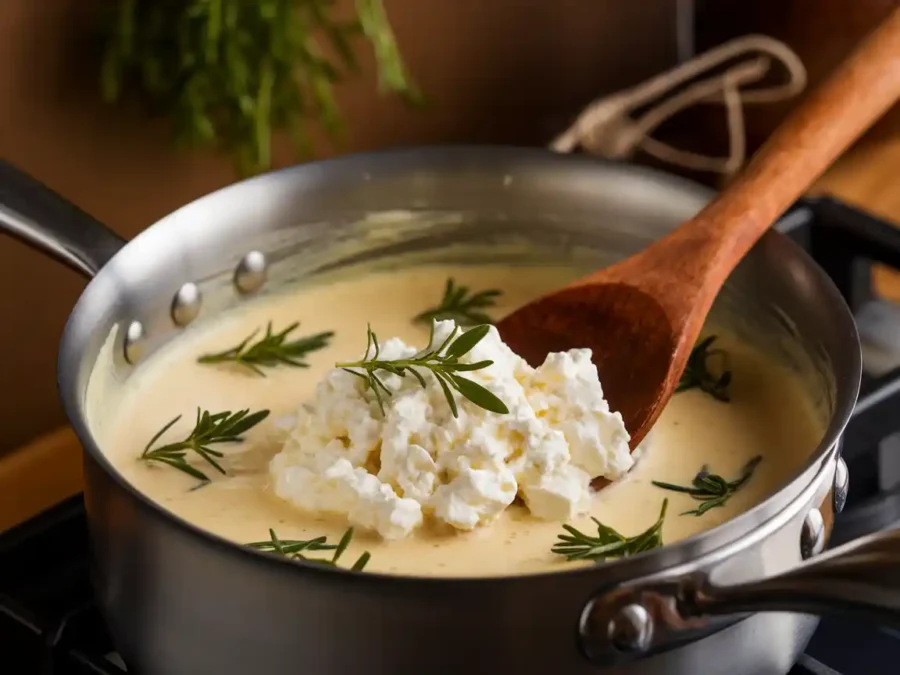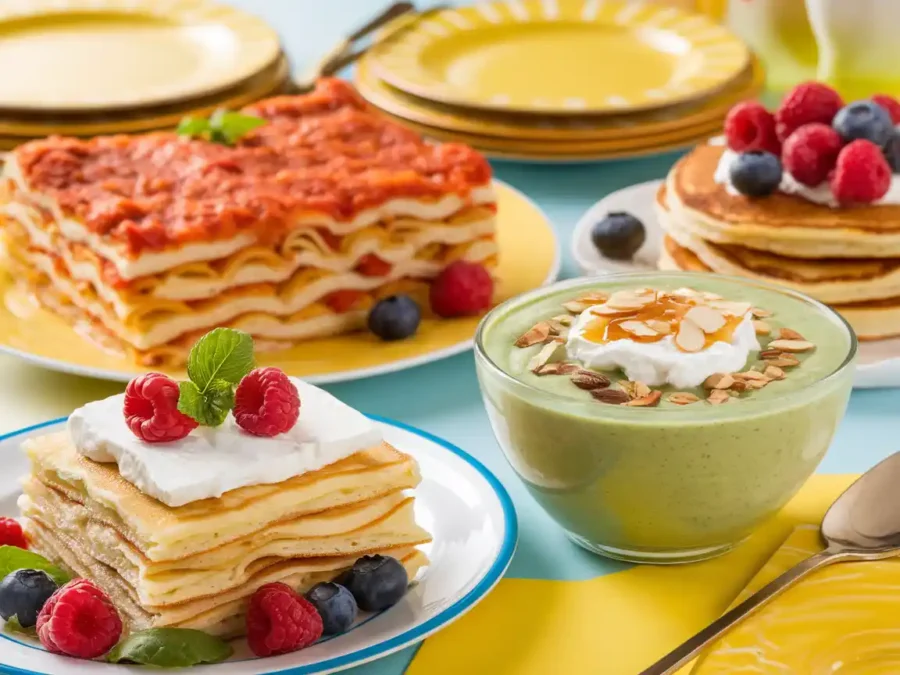Cottage cheese is a versatile and widely loved dairy product, but when it comes to cooking, many people wonder if it behaves like other cheeses. Does cottage cheese melt like cheese? Unlike cheddar or mozzarella, cottage cheese doesn’t quite turn into that gooey, stringy texture we often associate with melted cheese. Instead, it softens and transforms in unique ways that make it a standout ingredient in certain dishes.
In this article, we’ll explore the science behind cottage cheese, why it doesn’t melt like other cheeses, and creative ways to use it in your cooking. Let’s dive in, starting with the basics!
Table of Contents
Understanding Cottage Cheese
What is Cottage Cheese?
Cottage cheese is a type of fresh cheese made by curdling milk with an acid like vinegar or lemon juice. The curds are then separated from the whey, creating a soft, lumpy texture that’s distinct from aged cheeses. Unlike other cheeses, it’s not aged or pressed, which gives it a mild flavor and a light, creamy consistency.
Nutritionally, cottage cheese is a powerhouse. It’s packed with protein, low in fat (unless you opt for the full-fat variety), and rich in essential nutrients like calcium and vitamin B12. Its high water content makes it refreshing and light, but this also plays a key role in why it doesn’t melt like other cheeses.
How Cottage Cheese Differs from Other Cheeses
Unlike cheddar, mozzarella, or gouda, cottage cheese doesn’t have the dense fat content or structure that allows those cheeses to melt smoothly. It’s a fresh cheese, meaning it’s consumed shortly after being made, without the aging process that enhances flavor and melting properties in other cheeses.
The high water content in cottage cheese also contributes to its distinct behavior under heat. When warmed, the water evaporates, and the curds may soften, but they won’t achieve the gooey, stretchy texture of melted cheddar. Instead, the curds remain somewhat intact, giving dishes a creamy but chunky consistency.
Cottage cheese’s low-fat profile also makes it unique. Fat is a key player in the melting process for aged cheeses. Since cottage cheese is often lower in fat, it doesn’t exhibit the same transformation when heated.
The Science Behind Melting
Why Does Cheese Melt?
The melting of cheese is nothing short of culinary magic. When exposed to heat, cheeses like cheddar and mozzarella transform into gooey, stringy goodness due to their fat and protein composition. High-fat cheeses contain a balanced blend of proteins and water that emulsify during heating, creating that iconic melted texture.
The key players in this process are casein proteins, which form a matrix that traps fat and water. As heat disrupts this matrix, the cheese becomes liquid. However, factors like fat content, moisture level, and aging dramatically affect how a cheese melts. Aged cheeses tend to melt smoothly, while fresh cheeses, such as mozzarella or feta, may soften but not fully liquefy.
Why Cottage Cheese Doesn’t Melt Like Cheddar
Does cottage cheese melt like cheese? The answer lies in its unique structure and composition. Unlike cheddar, cottage cheese contains higher water content and minimal fat. These factors prevent it from undergoing the same melting process. Instead of becoming gooey, cottage cheese softens, and the curds may separate slightly when heated.
Its proteins are another reason it behaves differently. Cottage cheese is classified as a fresh cheese, meaning its proteins are not broken down through aging. Without this breakdown, the protein matrix doesn’t soften and melt in the same way. Additionally, the lack of emulsifiers makes cottage cheese prone to curdling when overheated.
Does Cottage Cheese Melt?

What Happens When Cottage Cheese is Heated?
When you heat cottage cheese, it doesn’t melt in the traditional sense. Instead, it softens and turns creamy, making it an excellent addition to certain dishes. The curds may integrate into sauces, soups, or casseroles, providing a delightful creamy texture. However, if heated too quickly or at high temperatures, it can curdle, leading to a grainy texture.
Unlike cheeses such as gouda or Monterey Jack, cottage cheese retains some of its structure when warmed. This makes it less ideal for applications like pizza toppings but perfect for blending into egg dishes or using as a creamy layer in lasagna.
Cooking Applications for Heated Cottage Cheese
While cottage cheese won’t replace mozzarella for that stretchy melt, it shines in other culinary roles. Here are some ideas:
- Creamy Sauces and Dips: Blend cottage cheese with spices for a rich dip. It’s especially popular in recipes like queso dips or creamy spinach spreads.
- Baked Goods: Add cottage cheese to muffins or casseroles for extra moisture and a protein boost.
- Soups and Stews: Stir it into hearty dishes to enhance creaminess without adding heavy cream.
Creative Ways to Use Cottage Cheese
Transforming Cottage Cheese in Recipes
While cottage cheese may not melt like cheddar, its creamy texture and subtle flavor open the door to countless culinary creations. By using it creatively, you can take your dishes to the next level. For instance:
- Cottage Cheese Queso Dip: Blend cottage cheese with spices and a dash of milk to create a silky dip for chips or vegetables. While it won’t provide the gooey melt of traditional queso, it offers a light, refreshing twist.
- Baked Casseroles: Mix cottage cheese into lasagna layers or pasta bakes for a protein-rich, creamy layer. Its moisture helps keep baked dishes tender and flavorful.
- Breakfast Ideas: Whisk cottage cheese into scrambled eggs or pancake batter for a fluffier texture. It also pairs wonderfully with fresh fruit or granola for a simple, satisfying morning meal.
Combining Cottage Cheese with Other Ingredients
One of the best things about cottage cheese is its versatility. It complements a wide variety of ingredients, both sweet and savory.
- In Soups and Stews: Stir in cottage cheese toward the end of cooking for a creamy boost without the heaviness of cream.
- Smoothies and Desserts: Blend it into fruit smoothies for a creamy texture or use it as a base for no-bake cheesecakes.
- Spreads and Toppings: Mix with herbs for a quick sandwich spread, or dollop on baked potatoes for a tangy topping.

The Role of Cottage Cheese in Health-Conscious Cooking
Why Cottage Cheese is a Healthier Alternative
Cottage cheese has earned its place as a health-conscious choice for many cooks. Its low-fat content, high protein, and essential nutrients make it an excellent option for anyone looking to enjoy dairy while maintaining a balanced diet. It’s often used in recipes that aim to lighten traditional dishes without sacrificing creaminess or flavor.
For instance, instead of heavy cream, you can add cottage cheese to soups, sauces, or even baked goods. Its unique texture allows it to blend easily, creating a creamy base with fewer calories. While it doesn’t melt like cheddar or gouda, does cottage cheese melt like cheese? No, but its versatility more than makes up for it.
Balancing Taste and Nutrition
The mild, slightly tangy flavor of cottage cheese works well in both sweet and savory dishes. It’s a great addition to breakfast bowls, smoothies, and even desserts. For savory recipes, its creamy consistency enhances pasta dishes, casseroles, and dips.
Cottage cheese also serves as a wonderful source of slow-digesting protein, keeping you fuller for longer. Its natural creaminess can replace heavier ingredients, making it a go-to choice for health-focused meals.
Creative Tips for Incorporating Cottage Cheese
Using Cottage Cheese in Everyday Recipes
The next time you’re cooking, think beyond the question Does cottage cheese melt like cheese? Instead, explore its potential in diverse recipes. For example:
- Baked Goods: Add cottage cheese to muffins or breads for added moisture and protein.
- Stuffed Vegetables: Use it as a filling for bell peppers or zucchini for a creamy, flavorful twist.
- Smoothies: Blend cottage cheese with fruit and honey for a rich, protein-packed breakfast.
These ideas not only enhance your dishes but also showcase the versatility of this unique cheese.
Pairing Cottage Cheese with Other Ingredients
Pairing cottage cheese with complementary ingredients elevates its flavor and texture. Combine it with herbs for a fresh spread, or mix it with nuts and honey for a dessert-like snack. If you’re in the mood for something savory, try blending it into mashed potatoes or spreading it on whole-grain toast.
While cottage cheese doesn’t melt, it integrates well into countless recipes, offering creaminess without the need for heavy fats or oils. Whether you’re making a health-conscious dish or indulging in comfort food, cottage cheese fits the bill.
Comparing Cottage Cheese to Melting Cheeses
Best Substitutes for Cottage Cheese in Recipes
When a recipe calls for a cheese that melts, does cottage cheese melt like cheese? Not quite. However, there are excellent substitutes depending on the dish. For creamy, smooth textures in sauces or dips, ricotta or cream cheese can step in. Both provide richness and blend seamlessly when heated.
For recipes that require stretch and gooeyness, like pizza or grilled cheese, mozzarella or Monterey Jack are ideal alternatives. These cheeses melt beautifully, creating that satisfying pull we all love. If you’re looking for a vegan option, cashew-based cheese spreads or nutritional yeast blended with plant milk can mimic the creaminess of melted cheese.
Cottage Cheese in the Culinary World
Cottage cheese is celebrated in the culinary world for its versatility and nutritional benefits. While it doesn’t behave like traditional melting cheeses, it offers something unique: a light, creamy texture that pairs well with both sweet and savory dishes. It’s also a favorite among health-conscious cooks, thanks to its high protein and low-fat profile.
Rather than seeing its lack of melting as a limitation, consider it an opportunity to explore new recipes. Cottage cheese excels in dishes that don’t rely on stretchy, melted cheese but instead need a creamy boost or a tangy flavor.
FAQs About Cottage Cheese
Why is My Cottage Cheese Flatbread Soggy?
If your cottage cheese flatbread turns soggy, it’s likely due to excess moisture in the cheese. Cottage cheese has a high water content, which can seep into the dough during baking. To prevent this, drain the cheese thoroughly before using or mix it with drier ingredients like ricotta or shredded cheese.
How Long Does the Cottage Cheese Flatbread Last?
Cottage cheese flatbread typically lasts 2-3 days when stored in an airtight container in the refrigerator. To maintain its freshness, warm it in an oven or toaster before serving.
Why is Cottage Cheese Not Keto?
Although cottage cheese is low in carbs, some varieties contain added sugars or higher lactose content, making them less suitable for strict keto diets. Always check the nutritional label and opt for full-fat versions with no added sweeteners.
Can Cottage Cheese Replace Melting Cheese in Recipes?
Does cottage cheese melt like cheese? While it doesn’t melt in the traditional sense, cottage cheese can be used creatively as a substitute. It works well in recipes where creaminess, rather than stretchiness, is needed. For example, use it in dips, sauces, or baked casseroles.
Conclusion
Summary of Findings
So, does cottage cheese melt like cheese? The answer is no, but that’s not a bad thing. Cottage cheese offers a unique texture and flavor that set it apart from traditional melting cheeses. Its high water content and fresh nature prevent it from becoming gooey, but it softens beautifully, making it a fantastic ingredient in countless recipes.
Whether you’re whipping up a creamy dip, a savory casserole, or a protein-packed breakfast, cottage cheese brings something special to the table. Its nutritional benefits and adaptability make it a kitchen staple worth celebrating.
Encouraging Experimentation
Don’t let cottage cheese’s lack of melting hold you back. Use it to create new and exciting dishes or to lighten up old favorites. Whether it’s a healthy smoothie, a cheesy spread, or a lasagna layer, cottage cheese proves time and again that it’s a versatile, valuable addition to your recipes.

